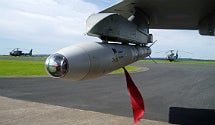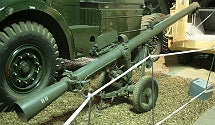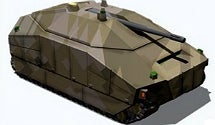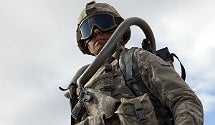
The military and its supporting defence industry are quite literally deadly serious. However, the acronyms they come up with to abbreviate complex systems and technical terms to make them pronounceable and memorable are sometimes by accident, or design, rather funny. Many of them display evidence of having started life as “backronyms”, names so awkward they must have started life in their shortened form then had a project title shoe-horned to fit.
Naughty but nice
A little innuendo never goes amiss among military personnel. Members of the US Army are known to dissolve into fits of giggles when the Advanced Short Range Air-Air Missile (ASRAAM), a heat-seeking missile produced by MBDA, is mentioned.
Perhaps a little more thought could have gone into Man-Portable Air-Defence Systems (MANPADS), which sounds more like a male-only incontinence solution than a shoulder-launched guided anti-aircraft munition; likewise the shortened form of military Production Reliability Acceptance Testing (PRAT). And a soldier could be forgiven for beginning to unbutton his uniform when asked to carry out a MILSTRIP, or Military Standard Requisitioning and Issue Procedure.
Other acronyms that raise a smile among the smutty-minded are US Navy’s Bureau of Medicine and Surgery (BUMED), the biennial Rim of the Pacific (RIMPAC) maritime warfare exercise and the US Air Force’s Basic Officer Training (BOT).
Animal inspired
The animal kingdom has long been an inspiring source of military acronyms. The US Navy’s special operations force has been known as the Navy SEALs has for so long that it has largely been forgotten it started life as an acronym itself, standing for Sea, Air and Land Teams, and nothing to do with marine mammals. They would be quite likely to use an innovative closed circuit breathing apparatus developed for Special Forces by Aqua Lung, known as the Full Range Oxygen Gas System (FROGS).
How well do you really know your competitors?
Access the most comprehensive Company Profiles on the market, powered by GlobalData. Save hours of research. Gain competitive edge.

Thank you!
Your download email will arrive shortly
Not ready to buy yet? Download a free sample
We are confident about the unique quality of our Company Profiles. However, we want you to make the most beneficial decision for your business, so we offer a free sample that you can download by submitting the below form
By GlobalDataA long-standing but hard to beat animal acronym is the British Army’s L6 WOMBAT, or Weapon Of Magnesium, Battalion, Anti-Tank 120mm calibre recoilless anti-tank rifle, dating back to the 1950s. However, the EU’s CORDIS research group used the same name for its recent effort to detect online behaviours that might signal a cyber attack, its Worldwide Observatory of Malicious Behaviours and Attack Threats project.
Other animals in the military menagerie are the US Air Force’s Crisis Action Team (CAT), World War II’s Women Airforce Service Pilots (WASP) and the US military’s personnel and benefits database Defense Eligibility Enrollment Reporting System (DEERS). DEERS is itself part of another glorious acronym, the Real-Time Automated Personnel Identification System (RAPIDS).
But perhaps the most imaginative, if not contrived, animal-based military acronym has to be the US Air Force’s Rapid Engineers Deployable Heavy Operational Repair Squadron Engineer (RED HORSE), which provides a civil engineering force to carry out urgent heavy damage repair of critical Air Force infrastructure.
Hard as nails
The obvious approach in the military is to make the acronyms sound as tough as possible, so the mere mention strikes fear into the heart of any enemy who might come up against them. Who would have a truck with, pun intended, FANG (Fast, Adaptable, Next-Generation Ground Vehicle), a futuristic Infantry Fighting Vehicle design being crowdsourced as part of DARPA’s Adaptive Vehicle Make portfolio of programmes.
Robot manufacturer Robosynthesis went out of its way to attract the acronym-loving military customer with its EXTRM (Extreme Modular Robotics Platform) range. Not content with that, its robots are offered with the SCRAM all-terrain system or CLAWWS stair-climb system, though exactly what these stand for is harder to discern.
The UK Ministry of Defence would have been hard-pressed to come up with a punchier name for its Future Infantry Soldier Technology programme than FIST, though it missed an opportunity by not embracing Lockheed Martin’s Human Universal Load Carrier (HULC) skeleton. The potential combination brings up comic-book images of HULC SMASH!
The US Air Force Research laboratory deserved high-fives all round for its Counter-electronics High-powered Microwave Advanced Missile Project (CHAMP), a technology demonstration project to develop an air launched directed-energy weapon to incapacitate electronic systems.
Laser weapons deserve an awe-inspiring name, and Northrup Grumman came up trumps with its All Semiconductor Airborne Laser Threat Terminator (ASALTT) designed to protect aircraft from a variety of threats. DARPA’s Helicopter ALert and Threat Termination (HALTT) technology shares similar acronym etymology but serves a different purpose, alerting helicopter aircrews to the source of gunfire by analysing its acoustic signature.
Another suitably martial-sounding acronym is the US Army’s acquisition programme for jammers to defeat remotely-operated roadside bombs, Counter Radio Controlled Improvised Explosive Device Electronic Warfare (CREW). However, the military missed an opportunity for not finding an Armed Forces specific use for High Energy Laser Meteorology (HELMET).
The best of the rest
Some military acronyms don’t readily fit into a category but deserve a mention for their sheer cleverness, such as the secure communications protocol Intrinsically Assured Mobile Ad-Hoc Networks (IAMANET) and DARPA‘s Centers for Integrated Photonics Engineering Research (CIPhER).
Others sound particularly mouth-watering, including DARPA’s solicitation for tiny lasers Nanoscale Architectures for Coherent Hyper-Optic Sources (NACHOS), and Sonardyne’s long-life sensor logging node Pressure Inverted Echo Sounder (PIES).
You could be forgiven for confusing your integrated optical circuit Fully Laser Integrated Photonics (FLIP) with your less-lethal crowd control weapon Discriminating Irritant Projectile (DIP).
Some veer into the biblical, including Lockheed Martin’s Area Defense Anti-Munitions (ADAM) ground-based anti-aircraft laser system and the US Air Force’s ejector seat High Altitude, Low Opening (HALO) survivability technique.
Whether you are developing Micro Navigation System (MINGS) or Network Enabled Weapons (NEW), chances are you’ll be employing some Common Off The Shelf (COTS) components.
It seems that not a week goes by without the military or the defence industry coming up with a new acronym to make a weapon, system or procedure memorable. Some of them may be memorable for reasons other than originally intended, having stumbled into the unintentionally funny. If there are others that tickle your funny bone we may have missed, be sure to let Army Technology know.
Related content
Electromagnetic pulse weaponry: Boeing CHAMP video and jammer grenades
Taking inspiration from science-fiction, the development of electromagnetic pulse-like weapons is about to jolt into life.
DARPA’s Cheetah robot outstrips Usain Bolt
Prior to testing in 2013, Boston Dynamics’s Cheetah robot has proven itself faster than Olympic champion Usain Bolt.
Military exoskeletons uncovered: Ironman suits a concrete possibility
As reality mimics Hollywood science-fiction, the US military are experimenting with exoskeleton body armour suits.








